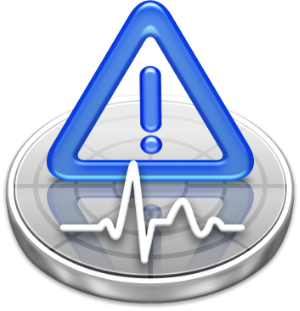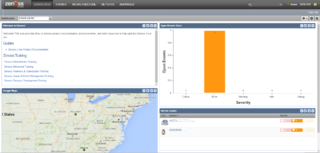Related Research Articles
Simple Network Management Protocol (SNMP) is an Internet Standard protocol for collecting and organizing information about managed devices on IP networks and for modifying that information to change device behavior. Devices that typically support SNMP include cable modems, routers, network switches, servers, workstations, printers, and more.

Mac OS X Server is a series of discontinued Unix-like server operating systems developed by Apple Inc. based on macOS. It provided server functionality and system administration tools, and tools to manage both macOS-based computers and iOS-based devices, network services such as a mail transfer agent, AFP and SMB servers, an LDAP server, and a domain name server, as well as server applications including a Web server, database, and calendar server.

Network mapping is the study of the physical connectivity of networks e.g. the Internet. Network mapping discovers the devices on the network and their connectivity. It is not to be confused with network discovery or network enumeration which discovers devices on the network and their characteristics such as. The field of automated network mapping has taken on greater importance as networks become more dynamic and complex in nature.

Cacti is an open-source, web-based network monitoring, performance, fault and configuration management framework designed as a front-end application for the open-source, industry-standard data logging tool RRDtool. Cacti allows a user to poll services at predetermined intervals and graph the resulting data. Through the use of Cacti plugins, it has been extended to encompass all of the FCAPS operational management categories. It is generally used to graph time-series data of metrics such as CPU load and network bandwidth utilization. A common usage is to monitor network traffic by polling a network switch or router interface via Simple Network Management Protocol (SNMP).

The Xserve is a discontinued series of rack-mounted servers that was manufactured by Apple Inc. between 2002 and 2011. It was Apple's first rack-mounted server, and could function as a file server, web server or run high-performance computing applications in clusters – a dedicated cluster Xserve, the Xserve Cluster Node, without a video card and optical drives was also available. The first Xserve had a PowerPC G4 processor, replaced by a PowerPC G5 in 2004, and by Intel Xeon processors in 2006; each was available in single-processor and dual-processor configurations. The Xserve was discontinued in 2011, and replaced with the Mac Pro Server and the Mac Mini Server.

XNU is the computer operating system (OS) kernel developed at Apple Inc. since December 1996 for use in the Mac OS X operating system and released as free and open-source software as part of the Darwin OS, which, in addition to being the basis for macOS, is also the basis for Apple TV Software, iOS, iPadOS, watchOS, visionOS, and tvOS.
Xserve RAID is a attachment mass-storage server that was offered by Apple Inc.

The Multi Router Traffic Grapher (MRTG) is free software for monitoring and measuring the traffic load on network links. It allows the user to see traffic load on a network over time in graphical form.

Xsan is Apple Inc.'s storage area network (SAN) or clustered file system for macOS. Xsan enables multiple Mac desktop and Xserve systems to access shared block storage over a Fibre Channel network. With the Xsan file system installed, these computers can read and write to the same storage volume at the same time. Xsan is a complete SAN solution that includes the metadata controller software, the file system client software, and integrated setup, management and monitoring tools.
Network monitoring is the use of a system that constantly monitors a computer network for slow or failing components and that notifies the network administrator in case of outages or other trouble. Network monitoring is part of network management.
Eric Zelenka is a Senior Worldwide Product Line Marketing Manager at Apple Inc. Prior to working at Apple, Zelenka worked for StarNine Technologies, Quarterdeck Office Systems, DoubleClick, and Mandala Communications.

Server Monitor is Apple's remote server monitoring application, part of the discontinued Mac OS X Server. It communicates with the hwmond hardware monitoring daemon present on Mac servers. Server Monitor is also an IPMI 2.0-based tool for communicating with a remote baseboard management controller (BMC) that implements their lights-out management (LOM) system. LOM is only supported on Xserve models released after 2006, not on Power Macs sold as servers. LOM enables power management even if the Xserve is off, and even if it lacks an installed operating system. Server Monitor can be configured to send notifications by email when a server encounters a problem, which requires the application to be running; the remote servers can also send these emails by themselves through hwmond.

The company Zenoss, Inc. was founded in 2005 and is headquartered in Austin, Texas. The company develops hybrid IT monitoring and analytics software.
In computing, the term remote desktop refers to a software- or operating system feature that allows a personal computer's desktop environment to be run remotely from one system, while being displayed on a separate client device. Remote desktop applications have varying features. Some allow attaching to an existing user's session and "remote controlling", either displaying the remote control session or blanking the screen. Taking over a desktop remotely is a form of remote administration.
The Remote Network Monitoring (RMON) MIB was developed by the IETF to support monitoring and protocol analysis of local area networks (LANs). The original version focused on OSI layer 1 and layer 2 information in Ethernet and Token Ring networks. It has been extended by RMON2 which adds support for Network- and Application-layer monitoring and by SMON which adds support for switched networks. It is an industry-standard specification that provides much of the functionality offered by proprietary network analyzers. RMON agents are built into many high-end switches and routers.
The following tables compare general and technical information for a number of notable network monitoring systems. Please see the individual products' articles for further information.
InterCon Systems Corporation was founded in April 1988 by Kurt D. Baumann and Mikki Barry to produce software to connect Macintosh computers in environments that were not Macintosh-exclusive. At the time, there was no real concept of the Internet and there was still a question of whether the TCP/IP protocols or OSI protocols would be adopted widely. Over the next 9 years, the company grew from three employees to over 100 and sold software in the US, Europe and Japan.
A number of tools exist to generate computer network diagrams. Broadly, there are four types of tools that help create network maps and diagrams:
PA Server Monitor is a server and network monitoring software from Power Admin LLC. PA Server Monitor focuses primarily on server and network health through numerous resource checks, reports, and alerting options. The agentless, on-premises software can monitor thousands of devices from a single installation. The monitored devices can be desktop computers, servers, routers and other devices.

PRTG is a network monitoring software developed by Paessler GmbH. It monitors system conditions like bandwidth usage or uptime and collect statistics from miscellaneous hosts such as switches, routers, servers, and other devices and applications.
References
- 1 2 3 Nance, Barry (2007-02-12). "Intermapper: Your network at a glance". Network World.
- ↑ Cook, Brad. "InterMapper 4.2.3 monitors Xserves". MacCentral. Archived from the original on 2011-06-11. Retrieved 2010-10-09.
- ↑ Nance, Barry (2001-03-22). "Two other 'network' monitoring options". IT World.
- ↑ "Response to RFP: Dartmouth College". Network World. 1999-08-23. Archived from the original on 2011-06-13. Retrieved 2010-10-09.
- 1 2 3 Berkley, Travis (1999-08-23). "Net monitoring tools stand watch". Network World. Archived from the original on 2010-04-19. Retrieved 2010-10-09.
- ↑ "InterMapper 5.1 adds map creation, probe groups". MacNN. 2009-03-12.
- ↑ "Intermapper Pricing, Maintenance, and Discount Information". www.fortra.com. Retrieved 2017-09-27.